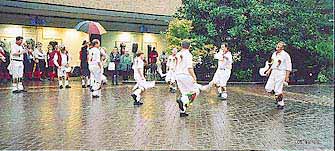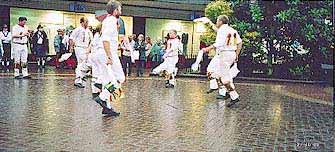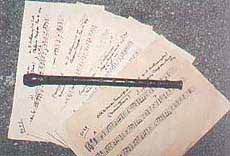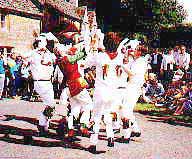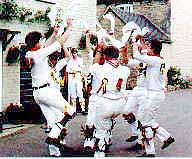
- an outline history
Keith Chandler
Bedford October 2000
(Photo Paul Bryan Guest Musician, Andy Doran playing Whistle)In the past several of the Chipping Campden dancers have expressed a desire for their history not to be published. However, with the passing of all but one of the oldest generation of performers still living when I started my fieldwork in the town sixteen years ago, and the recent integration of the present side into the wider context of the folk revival, it seems opportune for a little of that history to now be made available.
Less is known of the Chipping Campden Morris than any other of the three longest surviving traditions, at Abingdon, Bampton and Headington Quarry.
As with numerous other locations, the morris ceased at Campden about the middle of the nineteenth century. If an outsider hadn't married into one of the old dancing families forty years later and consciously revived the tradition of performance we might know as little about its history as we do about, say, the village where I live, South Leigh.
Given that the celebration known as Dover's Games had been held annually on a hill a mile outside Campden since the early seventeenth century, we might expect to hear of early and frequent references to a Campden team performing on these occasions. But no. In fact, there is no written confirmation of dance activity at the games until the third quarter of the eighteenth century.
But there are a couple of tantalising hints of the existence of a Campden Morris side prior to 1850. On a Sunday morning two weeks earlier than Whit Sunday, in May 1772, one William Keeley was teaching a set of morris dancers at The Fish public house on Broadway Hill. On his way home he spotted someone he knew paying for a drink from a large sum of money. Keeley followed this man (appropriately named Dyer), waylaid him, killed him with a hedgestake, and stole the money. Subsequently he was arrested, tried and hanged for murder.
Now, Keeley lived in Campden and was described in the contemporary newspaper accounts as 'a famous morrice dancer.' Given that he was actually teaching a group of men some miles away, a team in Campden itself is merely implied at this date.
The next we hear about a Campden Morris is more than half a century.
During the 1880s John Horne compliled a generalised manuscript history of morris dancing, in which he mentions that:
The last Dovershill meeting took place about the year 1852 and the Morris-dancers that year came from Longborough, and were joined by one or two old dancers from Campden.Once again, this is suggestive without giving too much away. The term 'old dancers' suggests that there had been a Campden dance set during the first half of the nineteenth century. But although the side from Longborough was the featured attraction at Dover's Games that year, the possibility that there was a Campden side still in existence cannot be ruled out. Only one morris set was allowed to dance on the Hill during the Games, and the way it was decided was to hold competitions beforehand, the winner gaining that honour. The likelihood that there was indeed a Campden team active during the early years of the 1850s is supported by a further piece of evidence.
In March 1895 one Denis William Hathaway married Campdonian Esther Louisa Veale. Her grandfather was Thomas Veale, born about 1829, who, when younger, had danced with the Campden side. Elsewhere in the South Midlands men claimed not to have danced until aged about eighteen or twenty, so Veale is unlikely to have been active as a dancer much before the middle years of the 1840s.
Given that he was only twenty-three years old when Dover's Games were finally suppressed it seems likely that the Campden side was, in fact, still active. Further, Veale was quite obviously not one of the 'old dancers' mentioned by Horne, suggesting the existence of a yet earlier Ccampden side. In 1910 Denis Hathaway told Sharp that 'the Campden dances proper were discontinued 50 years ago,' that is about 1860. A number of local dance teams abandoned performances following the last Dover's Meeting. Bidford was one, and Ilmington another. Presumably Campden was a third.
So, at Campden we have an extended gap in regular performance. For numerous complex social reasons morris dancing generally became outmoded during the second half of the nineteenth century. Whatever the reason, there was a period of inactivity which spanned four decades.
Craig Fees has demonstrated how during the mid-1890s there was a conscious effort to attract tourists to the town. One manner by which this was achieved was to organise spectacular fetes, with parade and processions, and all manner of 'Olde English' sports and pastimes. In 1896 the organisers hired the Shakespearian Bidford Morris Dancers to come over and perform at the Whit Monday Grand Floral Fete. Photographs taken that day show that there was also a Campden side present, dressed in morris dancing kit, with a musician, a fool and a spare man. The musician was Denis Hathaway, the fool was his father-in-law William Taylor, and one of the dancers was his brother-in-law, another William Taylor. I would like to suggest that this was probably the first appearance of a 'new' Campden side. If they had already been in existence why did the organisers import the Bidford dancers? Denis Hathaway was not a native of Campden: he was born at Condicote about 1867 and had only recently moved there. He had no recorded prior connection with morris dancing, beyond the fact that he remembered seeing the Longborough dancers at Stow and elsewhere when he was younger. It was details of the dances performed by these men, plus those remembered by his grandfather-in-law Thomas Veale, that he amalgamated to create what was essentially a completely new dance form.
Other men in the team on that day were William Howell, Richard James, Harry Day, James Edward Court, and George '90' Griffen. They continued to perform, at least on occasion. In addition to William Taylor, Thomas Sherwood acted as fool for them. One of the young boys who came to Campden with C.R. Ashbee's Guild of Handicrafts in May 1902 remembered seeing them perform shortly after he arrived. By 1906, however, none of the 1896 dancers were still active, and the dance tradition had become very much a family affair. Three of Denis Hathaway's brothers - Fred, Algy and Thomas - were dancers, as was one 'A. Veale,' who may probably be identified as Alfred Veale (a grandson of Thomas Veale, the old dancer). Other dancers were Fred Bennett, William Bunker and the postman George Webb. Most of these were members of the Town Band, and it was in this context that the morris dancers continued to appear during the first decade of the century: at the Whit Monday fetes, and at musical evenings in the Town Hall.When Cecil Sharp came to Campden in 1909 to deliver a lecture in a series organised by the Guild he learned of the Campden tradition of morris dancing.
There are several variants of the story whereby Sharp failed to get on with the adult dancers. Some have it he refused to buy them any beer, others that he borrowed a set of bells and never returned them. At any rate, they refused to dance for him, so over the following winter Denis Hathaway and his brother Fred were obliged to train a group of young boys drawn from the Boys Brigade, to demonstrate the dances. When Sharp returned in April 1910 these youngsters were ready, having already appeared at an entertainment in the Town Hall in February and been well received. Performers on that occasion included Don Ellis, who later became leader (he died as recently as 1993), Denis Hathaway's son Henry, Billy Figgett, George Payne, John Howell and George Smith. These boys also appeared at the annual celebration of Scuttlebrook Wake in Whitsun week, but had ceased activity before the First War.
Following the war a jazz band was raised in order to collect money for a War Memorial. This wasn't a jazz band in the true sense of the word, but a collection of odds and ends of instruments, plus Denis Hathaway playing the concertina. They entertained all round the area during 1919, but the first contemporary mention of the morris dancers in connection with it occurs as late as May 1920. At this date those involved were brothers Don, Lionel and Michael Ellis, Bert Hathaway (son of Denis, happily still living), Frank Bennett and Lance Weaver. At Scuttlebrook Wake there was a procession which went through the town:...They next proceeded to St. Catherine's-square, where the children were formed into a ring round the Jazz Band, when Morris dances were given by some of the members of the band. The procession was re-formed to the Square, where there was another performance by the Morris Dancers. Afterwards all proceeded to Leaseborne, where there were more Morris dancing and selections played by the Jazz Band...
This team also appear to have stopped shortly afterwards. In 1924 Denis Hathaway trained a group of men at nearby Broad Campden, but no names or other specific details are known. Apparently the Campden dancers didn't think much of the Broad Campden team and made them stop. There is, in fact, some confusion over the activity of the Campden dancers during this decade. Dick Merriman, for example, consistently maintained over numerous interviews that he had first danced when aged about fifteen or sixteen. If so, there must have been an otherwise undocumented attempt to restart the morris during the late 1920s.
There was certainly a further gap during which no dancing occurred, in public at least. Late in 1931, however, sufficient motivation was generated to allow a revival of the Campden side. The dances had ostensibly last been seen in public during the early 1920s, and from this group Don and Lionel Ellis, and Fred and Bert Hathaway (uncle and nephew) formed the core of the revived set. Denis Hathaway, who had acted as musician to every incarnation of the side since 1896, had passed away in 1926. It was thus that Bert learned to play the fiddle and became the musician for the side. Other men drafted in to complete the set were the brothers Bill and Dick Ferriman, Henry Owen Hart, Percy Newman, and Ben Benfield. Ormand Plested became fool and was widely renowned for his antics. The older dancers whom I interviewed spoke of him almost with reverence. The side practised during the winter of 1931/2, in preparation for an appearance at a folk festival organised by the English Folk Dance Society at the Albert Hall in London during February. In fact, one of Dick Merriman's greatest ever disappointments in life concerned this event. On the day of performance Dick was sick with the flu, and his brother Bill went to dance in his place.
From that date, with only minor changes in personnel, the team continued throughout the 1930s, with performances stimulated by frequent contact with the Travelling Morrice from Cambridge, a link still maintained to this day. During this period the side appeared frequently in the town and throughout the locality, at all manner of celebrations. I once asked Dick Merriman how many times he thought he had danced in the town square, and he replied 'hundreds.' In particular, they favoured events which raised money for charitable purposes, and never collected on their own behalf. As long as they got a cup of tea, Dick used to say, they were content.
The outbreak of war brought an end to regular performance, as many of the dancers joined the Armed Forces. At at least one Scuttlebrook Wake during the war there was morris dancing by a group of young girls, which included Don Ellis' daughter Jean. After the war the men reorganised very quickly and continued throughout the 1940s.Around 1948 or 1949 some younger men, including subsequent long-term dancers Norman and Bill Morrey, were inducted, and older men began to retire. Lionel Ellis left, then Dick Merriman put his foot down a rabbit warren in the Coneygree in 1953 and had to stop dancing. There was a very real crisis in numbers during the mid-1950s, so Don Ellis recruited some of the boys associated with the Youth Club, including the present leader David Hart. From that date on they have never looked back.
They travelled on many occasions to both Cambridge and to Bedford at the invitation of the local teams. In 1960 they first went to Bampton on Whit Monday. They danced at the Albert Hall by invitation of the EFDSS, and they've been on occasion to various folk festivals, including Bromyard and Sidmouth. About fifteen years ago they reintroduced (some say invented) Old woman tossed up in a blanket, a dance said to have been performed many decades ago.
In terms of numbers, some times have been lean, others expansive. In 1967 a boy's side was put together for Scuttlebrook Wake, consisting of sons of the adult dancers. Some of these later fed into the main team. Over the past decade there has been yet another influx of younger men, some of whom have danced with other sides. For the first time in many years, the present side contains two children, sons of older dancers. The present feeling among the dancers is that they want to slough off the rather parochial image they have and get into wider circulation.
At present there is only one elder statesman dancing regularly in the team, although they have several older men who will turn out on occasion. But when David Hart retires, and he is already nearing sixty, the tradition of dancing will reside in the hands of a group of young men, many of whom are fully integrated into the folk revival.
'The times they are a changing' indeed, and as we rush headlong into the twenty-first century, no one can say what the fate of the Campden tradition will be. Ask me again in ten years.
This is a photo of James Warner's tabor pipe. (Top four holes are blocked and one drilled in the back) Warner was a Campden man and played for a Morris side in the 1700s, this is believed to be his pipe and now resides in Gloucester Folk Museum. It visited Campden with a group of people interested in pipe and tabor playing last year. (2000)
NOTES:
The 1920 newspaper account is from the Evesham Journal and Four Shires Advertiser for 5 June 1920, page 7. The twentieth century history has been drawn mainly from oral interviews with many of the participants, especially between 1980 and 1990. Chief among these were Don Ellis, who was the custodian of the tradition and its history across more than eighty years, Lionel Ellis, Henry Owen Hart, Dick and Bill Merriman, Bert Hathaway, Bill and Norman Morrey, and David Hart.
Keith Chandler has written the following pieces about the history of morris dancing at Chipping Campden:
'The Archival Morris Photographs - 2: Campden Morrice Dancers, Chipping Campden, Gloucestershire, 1896', English Dance and Song 46, number 3 (Autumn/Winter 1984), 6-8
Obituary : Henry Owen Hart of Chipping Campden, The Morris Dancer 2, number 12 (February 1991), 216-217
Obituary : Richard Merriman of Chipping Campden, The Circular [of The Morris Ring of England] 21 (September 1992), 10-11
'Chipping Campden Morris Dancers - an outline history', The Morris Dancer 3, number 4 (February 1997), 111-116 [reproduced above]
On the wartime Campden girls side, posted on the Morris Dance Discussion List Internet site, 11 July 2000
More on Chipping Campden, posted on the Morris Dance Discussion List Internet site, 13 July 2000 To view this and the above piece, go to www.listserv.iupui.edu/archives/morris.html and type 'July 2000', 'Campden' or 'Keith Chandler' in the search box
'Three generations of morris dance musicians at Chipping Campden', Dance & Song 62, number 3 (Autumn 2000), 12-14
'Ribbons, Bells and Squeaking Fiddles' The Social History of Morris Dancing in the English South Midlands, 1660-1900 (Enfield Lock: Hisarlik Press, for the Folklore Society, 1993) [A general history of the social and cultural aspects of the custom, including celebrations such as Dover's Games, at which morris dancing was a feature. The book is out of print as at this date.]
Morris Dancing in the English South Midlands, 1660-1900 A Chronological Gazetteer (Enfield Lock: Hisarlik Press, for the Folklore Society, 1993) [An analysis of 151 locations in the south midlands which fielded a morris dance side between the dates given. These include Chipping Campden, Longborough, Lower Swell, Todenham, Stow-on-the-Wold, Ilmington, and many others. As far as the sources will allow, this work gives a chronology of performance, a list of known participants, a brief biographical string for each showing dates of birth and death and occupation as listed in all censuses between 1841 and 1891, details of familial inter-relationships, details of musicians, and a complete list of primary source material.]
Both the above works are due for republication, in CD ROM format only, in February 2001. To check availability go to www.mustrad.org.uk
Or to have your email address added to the list of those who would like to be notified when available, write to: keithc650@aol.com marking your message 'morris CD ROM'.
If you have any memories of morris dancing in the locality prior to about 1960, or if there are any stories within your family relating to either that or another custom called MUMMING (a short play taken round at Christmas) I would be delighted to hear from you. Please write me at: keithc650@aol.com
